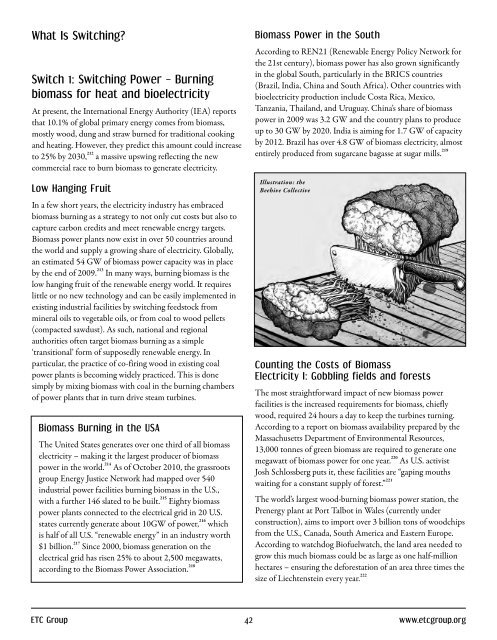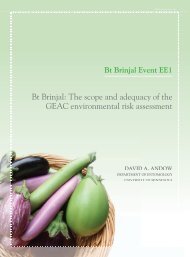It seems reasonable therefore that this product could impactthe price of rubber and therefore the livelihoods of small-scalerubber producers and plantation workers. By March 2010 itwas reported that Goodyear had already used Genencor’s“bioisoprene” to make synthetic rubber, which it then used tomake several prototype tires and was making its next decisionson building a pilot production plant. 203Flavourings – Glycyrrhizin is the sweet compound found inliquorice root that is 150-300 times sweeter than sucrose(table sugar) and is widely used as a natural sweetener as wellas a traditional natural medicine. Liquorice root is in highdemand, with supplies almost exclusively limited to wildindigenous species of the liquorice plant found in arid regionsof China, the Middle and Near East. In 2009, researchers atthe Japanese RIKEN Institute identified and synthesized allthe genes responsible for producing glycyrrhizin. 204 Accordingto researchers, it should now be possible to use syntheticbiology to induce a soy plant or a microbe such as yeast toproduce glycyrrhizin. If they are successful, it will be possibleto move liquorice production away from the Far and MiddleEast to industrial soybean fields or even proprietary vats.Soylent Green? – In October 2008, Synthetic Genomics, Inc.,the private firm run by synthetic biologist J. Craig Venter,received an $8 million investment from Malaysian palm oilconglomerate The Genting Group to decode the oil palmgenome. 205 While the cash injection was originally assumed tobe geared toward altering oil palm for biofuel production,more recent pronouncements by Venter suggest a verydifferent path. Speaking on U.S. television in 2010, Venterexplained that his company was now trying to use syntheticalgae to make food substances instead of harvestingplantations of oil palm. “You get 20 times the productivitytheoretically out of algae growing in a much smaller space…Instead of getting fish oil from killing fish we can remake it inalgae.” 206 Venter isn’t the only one looking for a biosyntheticreplacement for palm oil. In September 2010, the world’slargest purchaser of palm oil, food giant Unilever, announceda multimillion dollar investment in synthetic biology companySolazyme to develop algal oil that would replace palm oil infoods such as mayonnaises and ice creams as well as soaps andlotions. Unilever says they are currently three to seven yearsaway from rolling out a new biosynthetic food ingredient but,they emphasize that, “This isn’t just a niche application…Thisis something which we believe has tremendous capability.”Solazyme claims they can engineer “oil profiles” of algae anddevise replacements for different types of oil. While they saythey can do this with natural strains, they are hoping thatconsumer opposition to genetically modified foods will diedown to let them use synthetic biology. 207Nanocellulose – Shrinking biomassto grow new marketsBy modifying the fibres of cellulose at the atomic scale,nanotechnologists are opening up new uses, and thus newmarkets, for industrial biomass:Nanomaterials, energy and pharmaceuticals: While theposter child for nanomaterials, super strong carbonnanotubes (CNTs), are usually produced from graphite, itis also possible to produce CNTs from corn ethanol. 208Meanwhile, nanotechnologists are becoming increasinglyenamoured with a new class of nanostrctures known ascellulose nanocrystals (CNC). Derived from biomass,these CNCs can be added to plastics to make them 3000times stronger, can de designed to deliver drugs andvaccines, and can be used as scaffolds to grow metallicnanowires and particles in order to create tiny sensors andnew photovoltaic (solar electricity producing) materials. 209Body armour, medical devices and food: A form ofnanocellulose produced from wood pulp by Swedish firmInnventia is simultaneously marketed as being as strongand light as Kevlar, able to prevent food spoilage whenused in packaging, suitable for creating replacementhuman body parts in medical applications, and also edibleas low calorie filler for processed foods. The firstcommercial plant for this biomass ‘wonder material’ is dueto go into production in October 2010. 210Batteries: Nanotechnologists from Uppsala University inSweden reported that coated cellulose fibres from hairyalgae called Cladophora could make high quality paperbatteries. The nanocellulose batteries could hold 50 to200 percent more charge and be recharged many hundredsof times faster than conventional rechargeable batteries.“With the technique fully developed I believe that we maysee applications that we cannot really dream of today,”claims Maria Strømme one of the scientists who developedthe battery. “Try to imagine what you can create when abattery can be integrated into wallpapers, textiles,consumer packaging, diagnostic devices, etc.” 211Nanotechnology: tiny technology; nanotechnologyinvolves engineering matter on the scale of atoms andmolecules (~1-300 nanometers) in order to exploit novelproperties exhibited at this scale.The New Biomassters 41
What Is Switching?Switch 1: Switching Power – Burningbiomass for heat and bioelectricityAt present, the International Energy Authority (IEA) reportsthat 10.1% of global primary energy comes from biomass,mostly wood, dung and straw burned for traditional cookingand heating. However, they predict this amount could increaseto 25% by 2030, 212 a massive upswing reflecting the newcommercial race to burn biomass to generate electricity.Low Hanging FruitIn a few short years, the electricity industry has embracedbiomass burning as a strategy to not only cut costs but also tocapture carbon credits and meet renewable energy targets.Biomass power plants now exist in over 50 countries aroundthe world and supply a growing share of electricity. Globally,an estimated 54 GW of biomass power capacity was in placeby the end of 2009. 213 In many ways, burning biomass is thelow hanging fruit of the renewable energy world. It requireslittle or no new technology and can be easily implemented inexisting industrial facilities by switching feedstock frommineral oils to vegetable oils, or from coal to wood pellets(compacted sawdust). As such, national and regionalauthorities often target biomass burning as a simple‘transitional’ form of supposedly renewable energy. Inparticular, the practice of co-firing wood in existing coalpower plants is becoming widely practiced. This is donesimply by mixing biomass with coal in the burning chambersof power plants that in turn drive steam turbines.Biomass Burning in the USAThe United States generates over one third of all biomasselectricity – making it the largest producer of biomasspower in the world. 214 As of October 2010, the grassrootsgroup Energy Justice Network had mapped over 540industrial power facilities burning biomass in the U.S.,with a further 146 slated to be built. 215 Eighty biomasspower plants connected to the electrical grid in 20 U.S.states currently generate about 10GW of power, 216 whichis half of all U.S. “renewable energy” in an industry worth$1 billion. 217 Since 2000, biomass generation on theelectrical grid has risen 25% to about 2,500 megawatts,according to the Biomass Power Association. 218Biomass Power in the SouthAccording to REN21 (Renewable Energy Policy Network forthe 21st century), biomass power has also grown significantlyin the global South, particularly in the BRICS countries(Brazil, India, China and South Africa). Other countries withbioelectricity production include Costa Rica, Mexico,Tanzania, Thailand, and Uruguay. China’s share of biomasspower in 2009 was 3.2 GW and the country plans to produceup to 30 GW by 2020. India is aiming for 1.7 GW of capacityby 2012. Brazil has over 4.8 GW of biomass electricity, almostentirely produced from sugarcane bagasse at sugar mills. 219Illustration: theBeehive CollectiveCounting the Costs of BiomassElectricity I: Gobbling fields and forestsThe most straightforward impact of new biomass powerfacilities is the increased requirements for biomass, chieflywood, required 24 hours a day to keep the turbines turning.According to a report on biomass availability prepared by theMassachusetts Department of Environmental Resources,13,000 tonnes of green biomass are required to generate onemegawatt of biomass power for one year. 220 As U.S. activistJosh Schlossberg puts it, these facilities are “gaping mouthswaiting for a constant supply of forest.” 221The world’s largest wood-burning biomass power station, thePrenergy plant at Port Talbot in Wales (currently underconstruction), aims to import over 3 billion tons of woodchipsfrom the U.S., Canada, South America and Eastern Europe.According to watchdog Biofuelwatch, the land area needed togrow this much biomass could be as large as one half-millionhectares – ensuring the deforestation of an area three times thesize of Liechtenstein every year. 222ETC Group 42 www.etcgroup.org











